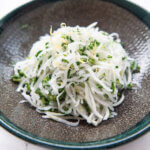
Salted Daikon Salad (Shio Momi Daikon) is almost like the preparation stage of daikon before making it into a more complex dish. It is a quick and easy salad. Because of its extreme simplicity, you can enjoy the natural raw daikon flavour.
Don't forget to see the section 'MEAL IDEAS' below the recipe card! It gives you a list of dishes that I have already posted and this recipe that can make up a complete meal. I hope it is of help to you.
- 200g/7.1oz daikon (a fat 5cm/2"-long disc or 2 thin 5cm/2"-long discs, skin removed, note 1)
- 40g/1.4oz daikon leaves (note 2)
- 2.5-3.5g/0.09-0.12oz salt (note 3)
- Lemon zest (for garnish, optional)
-
Slice the daikon vertically into 3mm/⅛"-thick slices, then cut them vertically into 3mm-thick batons.
-
Cut the daikon leaves into 3-5mm/⅛-3⁄16" pieces.
-
Put the daikon, leaves, and salt in a bowl. Mix well, ensuring that salt is evenly distributed.
-
Leave it for 10 minutes. The daikon pieces wilt.
-
Take a handful of daikon at a time and squeeze out most of the water from the daikon (note 4). Taste and add a little more salt if needed, then mix again (note 5).
-
Serve in a bowl with a small amount of lemon zests on top, if using.
1. You need to cut your daikon in the direction of the fibres when making thin batons, so each piece is the same length of the baton.
If you end up with more or less than 200g/7.1oz of daikon to use up the disc, that’s OK. You can adjust the amount of salt.
2. Use mostly the stem part of the leaves rather than the leafy tops.
If your daikon does not come with leaves, you can substitute it with white radish sprouts, snow pea sprouts, mitsuba, mizuna, or a small amount of finely chopped green onions. If you are using one of these substitutes, add it after the daikon is wilted.
You can also omit this, but it’s nice to have a touch of green colour in the dish.
3. The salt needs to be 1-1.5% of the combined weight of the daikon and leaves. Depending on your palate, you may find that 1% of salt is too light. It is best to start with 1% and adjust the saltiness at the end.
4. The amount of water you want to squeeze out of daikon depends on the texture of the salad you want. I like squeezing out quite a lot of water, but if you prefer a slightly wet daikon salad, you can leave a small amount of water in it.
5. Alternatively, you can serve the daikon without extra salt and let each person drizzle some soy sauce over the daikon when eating.
6. Nutrition per serving. The sodium should be much less in reality, since I did not take into account the discarded salty water squeezed out of the daikon.
serving: 121g calories: 23kcal fat: 0.1g (0%) saturated fat: 0g (0%) trans fat: 0g polyunsaturated fat: 0.2g monounsaturated fat: 0g cholesterol: 0mg (0%) sodium: 515mg (21%) carbohydrates: 5.2g (2%) dietary fibre: 2.4g (10%) sugar: 2.5g protein: 1.0g vitamin a: 1.6mcg (0%) calcium: 79mg (2%) iron: 1mg ( 2%) potassium: 307mg (9%)